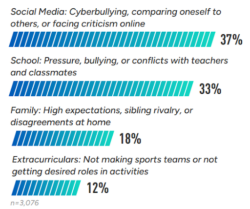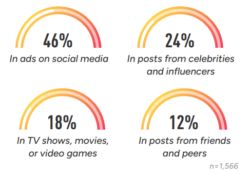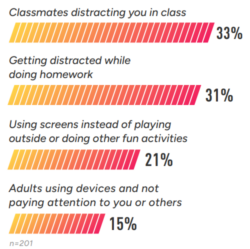Insights from the top Trending Lessons of the 2023-2024 School Year
There’s no better way to gear up for a new school year than to hear from the students themselves! When students feel heard and understood, they are 5x more likely to be engaged in school. At The Social Institute, we’ve discovered that equipping students and understanding them go hand-in-hand in fueling their health, happiness, and future success through the #WinAtSocial Lessons. Each lesson not only empowers students to navigate social media and technology positively but also provides data-driven insights into their needs, interests, and well-being. The more educators huddle with students through #WinAtSocial Lessons, the more they learn about them and are able to proactively tackle challenges students face in the classroom. To start preparing for the new school year, let’s dive into a few highlights from the wealth of insights gathered during the 2023-2024 year.
Insights From Trending Lessons: A snapshot
The 2024 Insights Report compiles anonymous polling data from our Trending Lessons, Year-Round Lessons, and our student survey, revealing the evolving interests and challenges students encounter. Throughout these lessons, students engage in various polls, debates, rankings, and discussions, with their responses quantified into actionable insights for educators and students to view. These insights provide educators with valuable opportunities to address students’ needs effectively.
Trending Lessons offer educators, students, and families a chance to engage in timely discussions on current events, such as a young athlete’s championship win or an international conflict. In the new school year, these insights can inform early decisions on cultivating a healthy classroom culture as educators prepare. Continue reading for highlights from last school year’s top Trending Lessons, and explore the full report here.
 In a 2023-2024 Trending Lesson that debuted on the heels of her epic athletic achievement, Learning from Coco Gauff’s US Open Win: Turning Others’ Negative into our Motivation, we learned where students most frequently encounter negativity. According to a poll, 37% of students reported that social media is the primary source of negativity, citing cyberbullying, comparisons, and online criticism. Another 33% pointed to school, mentioning pressures, bullying, and conflicts with teachers and classmates. Additionally, 18% of students identified family, while 12% mentioned extracurricular activities. Understanding these insights is crucial for educators, as it highlights the environments where students feel most vulnerable to negativity. With this knowledge, educators can create targeted interventions and support systems to help students navigate and overcome these challenges.
In a 2023-2024 Trending Lesson that debuted on the heels of her epic athletic achievement, Learning from Coco Gauff’s US Open Win: Turning Others’ Negative into our Motivation, we learned where students most frequently encounter negativity. According to a poll, 37% of students reported that social media is the primary source of negativity, citing cyberbullying, comparisons, and online criticism. Another 33% pointed to school, mentioning pressures, bullying, and conflicts with teachers and classmates. Additionally, 18% of students identified family, while 12% mentioned extracurricular activities. Understanding these insights is crucial for educators, as it highlights the environments where students feel most vulnerable to negativity. With this knowledge, educators can create targeted interventions and support systems to help students navigate and overcome these challenges.
 In addition to understanding sources of negativity, it’s also essential to address other significant influences on students’ well-being. With the rise of vaping and energy drink usage among students, this lesson for 5th-8th graders focused on Understanding how companies use media to advertise unhealthy energy drinks and vaping to students. In a poll, 46% of students reported that they most often encounter this content through ads on social media. Additionally, 24% see it in posts from celebrities and influencers, 18% in TV shows, movies, or video games, and 12% in posts from friends and peers. These results highlight the significant role that media plays in shaping young students’ perceptions and behaviors and offers educators an opportunity to have open discussion with students about how they are influenced by content online.
In addition to understanding sources of negativity, it’s also essential to address other significant influences on students’ well-being. With the rise of vaping and energy drink usage among students, this lesson for 5th-8th graders focused on Understanding how companies use media to advertise unhealthy energy drinks and vaping to students. In a poll, 46% of students reported that they most often encounter this content through ads on social media. Additionally, 24% see it in posts from celebrities and influencers, 18% in TV shows, movies, or video games, and 12% in posts from friends and peers. These results highlight the significant role that media plays in shaping young students’ perceptions and behaviors and offers educators an opportunity to have open discussion with students about how they are influenced by content online.

In addition to Trending Lessons, #WinAtSocial offers Year-Round Lessons that are regularly updated, feature age-appropriate content, and are applicable no matter what is going on in the world. In one of our Year-Round Lessons for 3rd Grade students entitled Dealing with screens during the day: What do you do?, students were asked to select the distracting event that happens to them most often during the week. This poll revealed that 33% of students are frequently distracted by classmates during class. Another 31% experience distractions while doing homework, 21% use screens when they could be engaging in outdoor or other fun activities, and 15% notice adults using devices and not paying attention to them or others. These insights are crucial for educators because they highlight the various ways screen time affects young students’ focus and behavior. By understanding these patterns, educators can develop strategies to minimize distractions, encourage healthier screen habits, and foster more engaging and attentive learning environments.
How to use insights to connect with students
The insights gathered from running #WinAtSocial Lessons have significant implications for educators, helping them identify areas where students need the most guidance and support. Here are three actionable steps educators can take by reviewing these insights:
- Develop Targeted Resources: Use #WinAtSocial insights to create resources that address specific challenges students face, fostering a deeper connection between educators and students and enhancing student engagement. If, for example, cyberbullying is a notable issue with students, play the Grade 8 Lesson Using student voice to strengthen our school culture and inclusivity to start discussions with students on how to stand up for their peers.
- Adapt Teaching Strategies: Modify your teaching methods based on real-time feedback and emerging trends from the data to ensure your approach remains relevant and effective. Use the tools at your disposal, including resources like our School Playbook: How to Help Students Handle the Pressure of Taking Tests, to address specific issues and enhance your teaching.
- Promote Continuous Improvement: Utilize a data-driven approach to continue seeking out student feedback and perspective. By playing #WinAtSocial lessons and gaining insights, educators can continue to understand student’s experience and then apply this knowledge to the classroom culture.
Preparing for the 2024-2025 School Year: Why insights matter
As the 2024-2025 school year approaches, the potential for learning and growth is enormous. But why is this important? By engaging with your students through #WinAtSocial Lessons, participating in open discussions, and analyzing anonymous lesson responses, educators can gain a deeper understanding of their students’ evolving needs and interests. This knowledge allows educators to tailor their strategies and resources to better support their students’ development and well-being.
To explore the full range of insights and trends from the past year, be sure to check out The Social Student Report. This comprehensive resource shows insights from nearly 30,000 students in The Social Institute’s Annual Student Survey and more than 1 million responses from K-12 students at schools across the U.S. and Canada, collected through our learning platform, #WinAtSocial. By leveraging these valuable insights, educators can create more engaging and supportive learning environments that truly meet the needs of their students.
